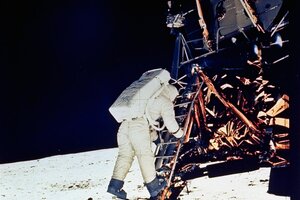Back to the moon
The Artemis space program is scheduled to return Americans, including the first woman, to the lunar surface in 2024. But can the US muster the political will to really make it happen?

Astronaut Edwin E. Aldrin Jr. descends the steps of Lunar Module ladder as he prepares to walk on the moon, July 20, 1969.
AP/NASA /FILE
Over the last half-century several nations have taken potshots at the moon, landing (or in some cases crashing) payloads onto the lunar surface. But only the United States has landed people on the moon: a dozen of them in six pairs, beginning with the historic Apollo 11 mission on July 20, 1969, and ending in December 1972.
That only men have visited the moon remains an accurate if unfortunate statement. Though women astronauts have roamed near-Earth orbit, none have ventured to Earth’s nearest neighbor.
That may change in as little as five years if NASA’s Artemis moon-landing program can stay on schedule. Artemis (in Greek mythology the twin sister of Apollo) would land a pair of astronauts, one expected to be a woman, on the lunar surface in 2024, ending a 55-year absence for humanity.
Explaining why humans must go to the moon was an easier task for President John F. Kennedy in 1962. The Cold War between the U.S. and the then-Soviet Union was at its most frigid. Political systems were being tested: Who could best accomplish the monumental task, a democracy relying on free enterprise and free debate or a secretive, closed, top-down autocracy demanding results? The American approach won the race easily – and with it the admiration of an astonished world.
But why go back? The scientific answer is simple: There’s much more to be learned. Artemis would land near the moon’s South Pole, unexplored by humans. It’s believed to have ice deposits that could be used to supply a permanent lunar base there, which could be occupied by 2028.
All this, of course, depends on whether political and financial support for Artemis will be sustained. The Trump administration has asked Congress for an extra $1.6 billion for NASA. But if budget standoffs between the White House and Congress continue, any boost of funding for space exploration may be hard to come by.
A recent tweet from President Donald Trump further clouded the political atmosphere by stating that Mars, not the moon, was the key destination for the U.S. That seemed like a return to the position of the Obama administration, which had decided to bypass the moon and concentrate on the Red Planet.
In his famous “moon speech” of 1962, President Kennedy made a clear and urgent case for why the U.S. must go to the moon.
The attempt he said, would not be made because it would be easy, but because it would be hard and would “measure the best of our energies and skills ... ,” he told an audience in Houston. “We set sail on this new sea because there is new knowledge to be gained, and new rights to be won, and they must be won and used for the progress of all people.”
If Artemis is to return humanity to the moon, it would benefit from that kind of clear vision and leadership to lift it off its launchpad.

